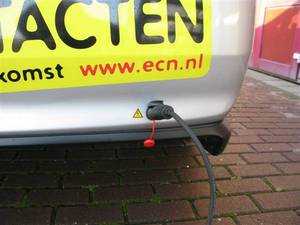PowerMatcher tested using Toyota Prius
PowerMatcher tested using Toyota Prius
More and more electrically-powered vehicles are appearing on the market. They are charged using the existing electricity grid. But the grid may be overloaded if an increasing number of consumers charge their vehicles at the same time. ECN examines how to avoid such a peak load in the electricity grid. The answer is by using ECN’s PowerMatcher. PowerMatcher is a software technology developed by the Energy Research Centre of the Netherlands (ECN). The technology harmonises the actions of electrical devices. To do so the software adds intelligence to devices like a battery charger for electrical vehicles. PowerMatcher determines automatically when the charger can best take electricity from the grid. It ‘sees’ when the electricity is expensive or inexpensive and whether there is a big or small supply of electricity and waits for the best moment to activate the charger. This controls the energy load on the grid to achieve the most favourable total load possible.

##Testing “To test PowerMatcher the ECN Efficiency & Infrastructure unit purchased a Toyota Prius,” explains Peter van der Laag, who works for ECN Intelligent Energy Grids. He is building up knowledge of grid-coupled electricity storage. “By charging the vehicle battery with PowerMatcher, we are studying how the battery responds, its efficiency, how long charging takes and what service life the battery has. The vehicle is equipped with test equipment to measure the battery’s behaviour and to analyse data”. The vehicle is eye-catching. Emblazoned with ECN logos and texts like I love stopcontacten [power outlets], the Toyota Prius catches the attention of many road users. Van der Laag: “We’ve replaced the standard battery by a far more powerful lithium ion battery with twelve times as much storage capacity, approximately 6 KWh. It is charged in the ordinary way using the grid, with a 1 kW charger fitted in the boot. We will soon have a rapid charger that lets the vehicle cover 45 km electrically with just a 30-minute charging time. This is enough capacity for a majority of journeys. With a full tank of petrol is possible to drive more than 900 km.”
##Future The Policy Studies unit and Engineering & Services unit are also involved in the research. Together with research and test institute KEMA and grid operators, the Policy Studies unit is examining the pros and cons of introducing electrical vehicles on a large scale. Engineering & Services is responsible for making technical modifications to the vehicle and for the grid connection. A unique possibility is that PowerMatcher could also be capable of supplying electricity to the grid from the vehicle’s battery. Talks are currently in progress with market parties on the marketing of PowerMatcher.





